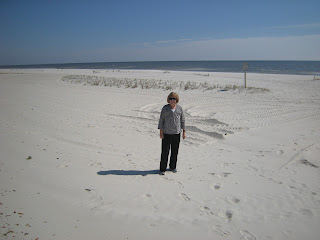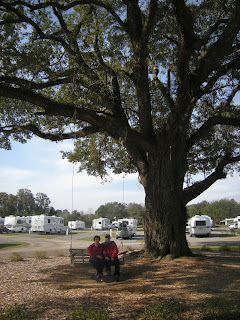Feb. 9
Before leaving the New Orleans area, we drove over to the Jean Laffite National Park to see the bayous of the Barataria Preserve hoping to see alligators. No luck on the alligator sightings but a nice walk through the bayou with Cyprus trees and small palms called Saw Palmettos. The large canal was man made to transport sugar cane for a nearby plantation. Jean Laffite was a privateer in this area in the early 1800’s. By 1812, this New Orleans business man was the leader of 1,000 Baratarians smuggling in store goods and slaves. He was jailed and escaped by 1814 to become an asset to the US Navy and Army warning them of a British attack. General Jackson accepted his help to bring in ammunition and supplies for the battle of New Orleans. He called Laffite a “hellish banditti.”
We drove through Mississippi along the coast through Biloxi to Mobile and on to Pensacola, old stamping grounds for Norm when he was in the Air force. We saw “for sale” signs for beach property by the dozens. Lot after lot must have been leveled by Hurricane Katrina in 2005. Some of the grand old homes survived and new ones were being built but you could have your choice of building lots. New resort facilities have been built, hopefully not to be leveled soon by another hurricane. The gulf coastline is gorgeous and we took a walked on the sand. We sat outside for lunch at Snuggy’s on the beach. The rest of the afternoon and evening was spent getting organized in the manor for the months ahead. It feels good to be done with hotels and in our cozy home! Eating some home cooked meals will be nice for a change. Norm’s birthday is coming up so our dinners won’t all be home cooked this next week.
Feb. 10
We drove down to the coast this morning to see the white sands and turquoise water of the Gulf. The sand is amazing & reminded me of the white sand in Cancun. We are hoping to have more sun tomorrow to really get the sparkle. We drove out on a spit to the Gulf Island National Seashore. It goes for miles across Mississippi and Florida to include the Barrier Islands and coastal marches. 80 % of the park is submerged. The ever changing islands with sea oats growing as a stabilizer actually form a barrier to help protect the coast from hurricane damage. At the tip of the spit is Fort Pickens dating back to 1825. The brick fort was modernized, as cannons improved, with cement fortifications that were used clear up to World War II. This area has been under the rule of five different flags. The fort was held by the Union Army throughout the Civil War. We picked up sea shells along the beach, not in the National Park of course, and did some bird watching. There are a number of large heron and osprey nests atop dead trees. We were lucky to see a pair of heron sitting in their nest and an osprey heading back to its nest carrying a fish.










Both my thumbs up Kathy!!! Your blog and pictures are fantastic!!
ReplyDelete